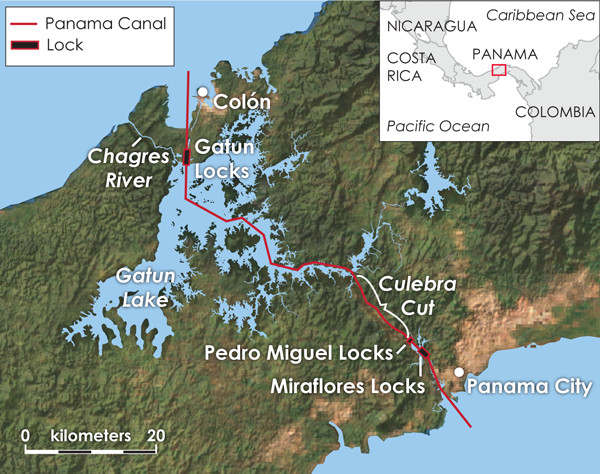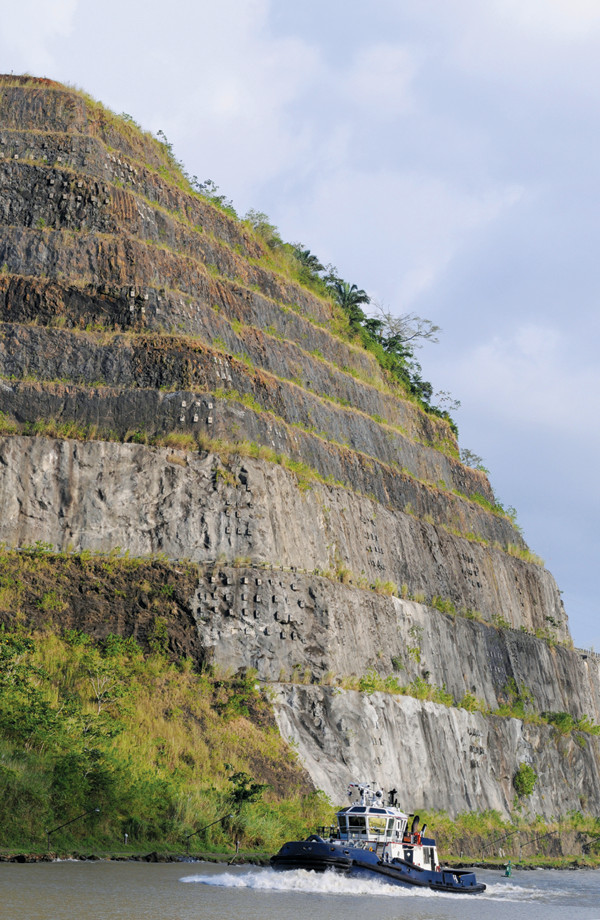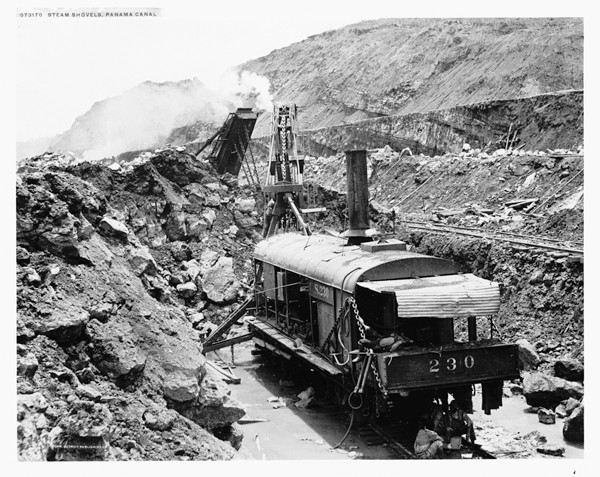
by Allison Mills Tuesday, September 2, 2014
On Oct. 10, 1913, U.S. President Woodrow Wilson pressed a button in his Washington, D.C., office. At that moment, more than 6,400 kilometers away, about seven metric tons of dynamite exploded, clearing the final obstruction in the Panama Canal. Deep within the Culebra Cut, waters from the Atlantic Ocean finally met waters from the Pacific Ocean, marking the end of major construction on the 77-kilometer-long canal.
Breaching the Isthmus of Panama — a strip of land only a few tens of kilometers wide linking North and South America — would save ships from having to sail around Cape Horn at the southern tip of South America, thousands of kilometers out of the way. It was an achievement four centuries in the making.

Panama's lock-and-dam canal winds northwest-southeast from Limon Bay to Colón on the Atlantic side, and then through Gatun Lake, for almost half its length. The southern section slices through the Continental Divide at the Culebra Cut before reaching the canal's Pacific entrance at Panama City. Credit: Kathleen Cantner, AGI.
Soon after undertaking exploration of the New World, the Spanish realized they needed quicker passage to the Pacific than skirting around the entire South American continent. In the early 1500s, Vasco Balboa built a road across the Panamanian isthmus to promote European trade and expansion. During the following centuries, many explorers, traders and empires dreamed of making the shortcut by water. But the Central American jungle was an inhospitable environment for such projects. The heat and humidity were tough on travelers and workers — but it was mosquitoes that would do them in.
In the early 19th century, several countries considered plans to build a canal. The United States and Great Britain together first tried to build one through Nicaragua during the 1850s, but the project didn’t get past the planning stages. The French then tried in Panama: Ferdinand de Lesseps, who designed the Suez Canal in Egypt, led the team, and excavation began in 1880. After nine years, they hadn’t even reached the halfway mark, and along with the loss of 20,000 lives due to accidents, malaria, yellow fever and other tropical diseases, the project went bankrupt.

A tugboat passes through the Culebra Cut — deepened from 95 meters above sea level to 12 meters — where the canal cuts through the Continental Divide. Credit: ©iStockphoto.com/Nancy Nehring.
Despite the risk, the United States remained interested in completing the canal. They recruited Philippe Bunau-Varilla, an engineer from the earlier French attempt, to help lead the construction, and by 1902 several treaties with Colombia — which controlled Panama at the time — licensed the United States to build its own canal. The U.S. Senate was keen to maximize the opportunity, for both commercial and military reasons; the Senate approved a treaty to initiate canal construction, but the Colombian Congress refused, citing disagreeable financial terms and threats to sovereignty.
U.S. President Theodore Roosevelt responded by sending warships to Panama City and Colón; U.S.-operated railroads in Colombia were also shut down. These actions were taken under the guise of supporting Panamanian independence, because Panama was willing to support the canal project. On Nov. 3, 1903, when Colombian troops failed to cross the Darién Gap, Panama declared independence. Three days later, the newly formed Panama and the United States ratified a canal treaty in which the United States received a 16-kilometer-wide strip of land in exchange for a one-time payment of $10 million and an annual payment of $250,000, starting after nine years. The French engineer, Bunau-Varilla, negotiated the treaty and was promoted to Envoy Extraordinary and Minister Plenipotentiary by the Panamanian government.

Engineers were initially unprepared for the quantity of weathered material while building the canal; this and large amounts of rain created dangerous conditions ripe for landslides like this one at Gold Hill (left). Credit: Library of Congress.
At the time of construction, scientists were more concerned with eradicating mosquitoes and tropical diseases than they were with documenting rock formations. This would have been difficult at the time anyway, because rock outcrops in the jungle were buried beneath meters of soil and weathered material. While engineers and work crews moved massive amounts of rock and debris, they didn’t stop to distinguish the material by grain size or composition. In historical documents, it was all called “spoil” — indistinguishable and otherwise useless material, good only for building up dams and filling dump sites.
The Isthmus of Panama formed at the intersection of the Cocos, North American and South American plates, a process that took more than 90 million years. Since the Late Cretaceous, tectonic influences have shaped, warped and built up the isthmus, beginning with mafic volcanism associated with the Caribbean Large Igneous Province. This basement was intruded by arc plutons and mafics overlain by marine sediments, the latter of which make up most of the canal basin.
Given the tectonic setting, volcanoes and earthquakes abound. But even with these geologic hazards, the greatest challenge for the canal excavators remained surficial.
Landslides in the Culebra Cut slowed construction progress significantly. Engineers not only underestimated the amount of material that had to be removed, but also did not account for saturated sediments and highly weathered sedimentary rock. Two types of landslides occurred along the canal: slumps — or gravity slides — like at Cucaracha, and deformation rock slides like at Gold Hill.
The Cucaracha slides started after heavy rains saturated porous sediment layers above hard, less porous rock layers, creating a lubricated zone at the contact. More troublesome were the Gold Hill and other slides caused by construction of the canal. Deep excavation decreased lateral support of the canal’s banks. Unable to support the weight above, the rock at the base of the canal gave way, sending large amounts of debris back into the canal.
Dealing with the jungle and the geology of the canal called for innovation.

The steam shovel was a key piece of equipment during excavation. Credit: Library of Congress.
Construction of the canal would have proved impossible if not for major innovations in engineering equipment. During the previous French-led canal-building effort, most of the excavation was done by hand, but several machines proved vital to the United States’ success: steam shovels, special dump cars, dirt-spreaders and track-shifters.
The excavation process began in a similar way to mining: Holes were drilled, filled with explosives and detonated, leaving extensive piles of dirt, rock and rubble — spoil. Steam shovels loaded the spoil onto the dump cars, which were modified to have only one sidewall and to be open on the other three, along with steel platforms connecting the train cars. These cars, connected like the segments of a centipede, had material piled against the single sidewall. A plow, which was set at the back of the train and attached to a cable and winch powered by the locomotive in the front, shoved through the spoil, dumping it off the rail cars. The technique emptied a 20-car train in less than 10 minutes and set a record by clearing 5.6 kilometers of railcars, carrying about 5,780 cubic meters of spoil, in eight hours. With just 180 workers operating 30 plows, crews could do the work of 8,500 laborers working by hand.
Once unloaded, the material had to be spread away from the tracks. The dirt-spreader could do the work of hundreds of men working by hand. The machine, powered by compressed air, had two steel arms that extended 3 meters out on either side of the tracks, pushing the mounds left by the dump cars.
With the constant influx of material and the expediency of the delivery equipment, rail tracks had to be regularly moved to keep from being inundated. The track-shifter looked like a crane and could pick up a section of railroad — tracks, ties and all — and move it up to 3 meters at a time. With fewer than a dozen workers needed, the track-shifter moved up to 1.6 kilometers of track in a single day, a task that would have required at least 600 laborers.
The final section of the Panama Canal, known as the Culebra Cut (formerly the Gaillard Cut), comprised 18 percent of the total length of the canal and took more than four years to complete. It has been called “the special wonder of the canal” and was part of the reason the American Society of Civil Engineers named the Panama Canal one of the seven wonders of the modern world. What made excavating the Culebra Cut so challenging was the amount of rock moved, the rising cost and frequent landslides.
During the United States-led excavation of the Panama Canal, a total of 184 million cubic meters of earth were removed at a cost of $400 million. Engineers initially estimated that 41 million cubic meters of material would need to be removed from the Culebra Cut alone. However, the final amount of material removed was closer to 77 million cubic meters. Although the canal bottom in the Culebra Cut was widened by 30 meters during this time, this only resulted in an increase of about 10,000 cubic meters. The majority of the increase came from grossly underestimating the total amount of spoil to be removed as well as a series of landslides.
A deformation slide on the west bank near the Culebra village resulted in an extra 8 million cubic meters of material, and another on the east bank north of Gold Hill resulted in an extra 5 million cubic meters. The Cucaracha slumps contributed less material initially, but continued to dump sediment into the canal for years.""
Major construction ended with a bang when President Wilson set off the dynamite that blasted away the last of the Gamboa Dike in the Culebra Cut on Oct. 10, 1913. A New York Times article from the day reported that the explosion occurred at “two minutes past 2 o’clock” and that “intrepid canal workers, who had been hovering about the lake in canoes, turned the noses of their canoes and launched into the rapids caused by the rushing of the water into the cut, while a great throng on the bank cheered wildly and the whistles of locomotives and dredges shrieked a long, piercing salute as the first vessels to make the passage passed through in safety.”
Large vessels could not pass through until Aug. 15, 1914, which marked the end of canal construction. Ever since, the Panama Canal has been an important trade route — and, for a while, was a geopolitical sticking point. Within a few years, Panama began requesting a transfer of management and ownership of the canal. In 1977, U.S. President Jimmy Carter agreed to turn over the canal by the end of the century and signed a treaty with Panamanian dictator Omar Torrijos. The peaceful transfer of the Panama Canal occurred at noon on Dec. 31, 1999.
© 2008-2021. All rights reserved. Any copying, redistribution or retransmission of any of the contents of this service without the expressed written permission of the American Geosciences Institute is expressly prohibited. Click here for all copyright requests.